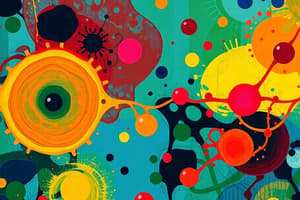Podcast
Questions and Answers
Which type of nutrition involves organisms synthesizing their own food?
Which type of nutrition involves organisms synthesizing their own food?
- Parasitic nutrition
- Heterotrophic nutrition
- Photosynthetic nutrition
- Autotrophic nutrition (correct)
What is the primary process through which organisms remove waste products?
What is the primary process through which organisms remove waste products?
- Excretion (correct)
- Respiration
- Digestion
- Reproduction
Which type of chemical reaction involves a single compound breaking down into two or more products?
Which type of chemical reaction involves a single compound breaking down into two or more products?
- Decomposition (correct)
- Combination
- Redox reaction
- Displacement
What is the flow of electric charge commonly referred to as?
What is the flow of electric charge commonly referred to as?
Which of the following best describes Ohm's Law?
Which of the following best describes Ohm's Law?
What type of circuit has all components connected across the same two points?
What type of circuit has all components connected across the same two points?
Which type of respiration occurs in the absence of oxygen?
Which type of respiration occurs in the absence of oxygen?
Which indicator would suggest a chemical reaction has taken place?
Which indicator would suggest a chemical reaction has taken place?
Study Notes
Life Processes
- Definition: Life processes are essential functions that living organisms perform to maintain life.
- Key Processes:
- Nutrition:
- Involves intake of food and its utilization.
- Types: Autotrophic (self-synthesis; e.g., plants) and Heterotrophic (obtaining food from others; e.g., animals).
- Respiration:
- Process of breaking down food to release energy.
- Types: Aerobic (with oxygen) and Anaerobic (without oxygen).
- Transportation:
- Movement of substances (nutrients, gases) within the organism.
- In humans, involves the circulatory system (heart, blood vessels).
- Excretion:
- Removal of waste products from the body.
- Involves kidneys in humans, which filter blood to form urine.
- Reproduction:
- Process of producing offspring.
- Can be sexual (involving gametes) or asexual (without gametes).
- Nutrition:
Chemical Reactions
- Definition: A chemical reaction involves the transformation of reactants into products through the breaking and forming of bonds.
- Types of Reactions:
- Combination: Two or more substances combine to form a single product (e.g., A + B → AB).
- Decomposition: A single compound breaks down into two or more products (e.g., AB → A + B).
- Displacement: An element displaces another in a compound (e.g., A + BC → AC + B).
- Redox Reactions: Involves oxidation (loss of electrons) and reduction (gain of electrons).
- Indicators of Chemical Reactions:
- Color change
- Temperature change
- Formation of gas (bubbles)
- Formation of precipitate (solid)
Electricity
- Definition: Electricity is the flow of electric charge, typically through conductors like metals.
- Key Concepts:
- Current:
- Flow of electric charge (measured in Amperes).
- Types: Direct Current (DC) flows in one direction; Alternating Current (AC) changes direction periodically.
- Voltage:
- Electric potential difference between two points (measured in Volts).
- Resistance:
- Opposition to the flow of current (measured in Ohms).
- Factors affecting resistance: Material, length, cross-sectional area, temperature.
- Ohm's Law:
- Relationship between voltage (V), current (I), and resistance (R): V = I × R.
- Series and Parallel Circuits:
- Series: Components connected end-to-end; total resistance increases.
- Parallel: Components connected across the same voltage source; total resistance decreases.
- Current:
Life Processes
- Life Processes: Essential functions enabling organisms to sustain life.
- Nutrition:
- Intake and utilization of food.
- Autotrophic organisms synthesize their own food (e.g., plants).
- Heterotrophic organisms obtain food from external sources (e.g., animals).
- Respiration:
- Breakdown of food for energy release.
- Aerobic respiration requires oxygen, while anaerobic occurs without it.
- Transportation:
- Movement of nutrients and gases within an organism.
- In humans, the circulatory system (heart and blood vessels) facilitates this process.
- Excretion:
- Removal of waste products.
- In humans, kidneys filter blood to produce urine.
- Reproduction:
- Offspring production through sexual (involving gametes) or asexual (without gametes) methods.
Chemical Reactions
- Chemical Reaction: Transformation of reactants into products through bond changes.
- Types:
- Combination: Multiple substances combine to form one product (e.g., A + B → AB).
- Decomposition: A single compound separates into two or more products (e.g., AB → A + B).
- Displacement: An element replaces another in a compound (e.g., A + BC → AC + B).
- Redox Reactions: Processes involving oxidation (loss of electrons) and reduction (gain of electrons).
- Indicators of Reactions:
- Observable changes such as color alteration, temperature variation, gas formation (bubbles), or solid formation (precipitate).
Electricity
- Electricity: Flow of electric charge through conductors, primarily metals.
- Key Concepts:
- Current: Movement of electric charge, measured in Amperes.
- Types: Direct Current (DC) flows unidirectionally; Alternating Current (AC) reverses direction periodically.
- Voltage: Electrical potential difference between two points, measured in Volts.
- Resistance: Opposition to current flow, measured in Ohms.
- Influenced by material, length, cross-sectional area, and temperature.
- Ohm's Law: Describes the relationship between voltage (V), current (I), and resistance (R) with the formula V = I × R.
- Circuits:
- Series Circuits: Components connected sequentially; total resistance increases.
- Parallel Circuits: Components connect across the same voltage source; total resistance decreases.
- Current: Movement of electric charge, measured in Amperes.
Studying That Suits You
Use AI to generate personalized quizzes and flashcards to suit your learning preferences.
Description
Explore the essential life processes that living organisms perform to sustain life, including nutrition, respiration, transportation, excretion, and reproduction. Learn how these vital functions relate to chemical reactions within organisms and their significance in life sciences.




